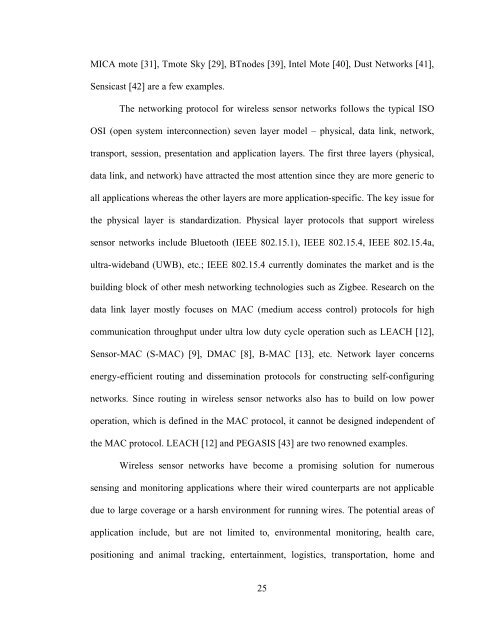Wireless Sensor and Actuator Networks for Lighting Energy ...
Wireless Sensor and Actuator Networks for Lighting Energy ...
Wireless Sensor and Actuator Networks for Lighting Energy ...
Create successful ePaper yourself
Turn your PDF publications into a flip-book with our unique Google optimized e-Paper software.
MICA mote [31], Tmote Sky [29], BTnodes [39], Intel Mote [40], Dust <strong>Networks</strong> [41],<br />
Sensicast [42] are a few examples.<br />
The networking protocol <strong>for</strong> wireless sensor networks follows the typical ISO<br />
OSI (open system interconnection) seven layer model – physical, data link, network,<br />
transport, session, presentation <strong>and</strong> application layers. The first three layers (physical,<br />
data link, <strong>and</strong> network) have attracted the most attention since they are more generic to<br />
all applications whereas the other layers are more application-specific. The key issue <strong>for</strong><br />
the physical layer is st<strong>and</strong>ardization. Physical layer protocols that support wireless<br />
sensor networks include Bluetooth (IEEE 802.15.1), IEEE 802.15.4, IEEE 802.15.4a,<br />
ultra-wideb<strong>and</strong> (UWB), etc.; IEEE 802.15.4 currently dominates the market <strong>and</strong> is the<br />
building block of other mesh networking technologies such as Zigbee. Research on the<br />
data link layer mostly focuses on MAC (medium access control) protocols <strong>for</strong> high<br />
communication throughput under ultra low duty cycle operation such as LEACH [12],<br />
<strong>Sensor</strong>-MAC (S-MAC) [9], DMAC [8], B-MAC [13], etc. Network layer concerns<br />
energy-efficient routing <strong>and</strong> dissemination protocols <strong>for</strong> constructing self-configuring<br />
networks. Since routing in wireless sensor networks also has to build on low power<br />
operation, which is defined in the MAC protocol, it cannot be designed independent of<br />
the MAC protocol. LEACH [12] <strong>and</strong> PEGASIS [43] are two renowned examples.<br />
<strong>Wireless</strong> sensor networks have become a promising solution <strong>for</strong> numerous<br />
sensing <strong>and</strong> monitoring applications where their wired counterparts are not applicable<br />
due to large coverage or a harsh environment <strong>for</strong> running wires. The potential areas of<br />
application include, but are not limited to, environmental monitoring, health care,<br />
positioning <strong>and</strong> animal tracking, entertainment, logistics, transportation, home <strong>and</strong><br />
25
















